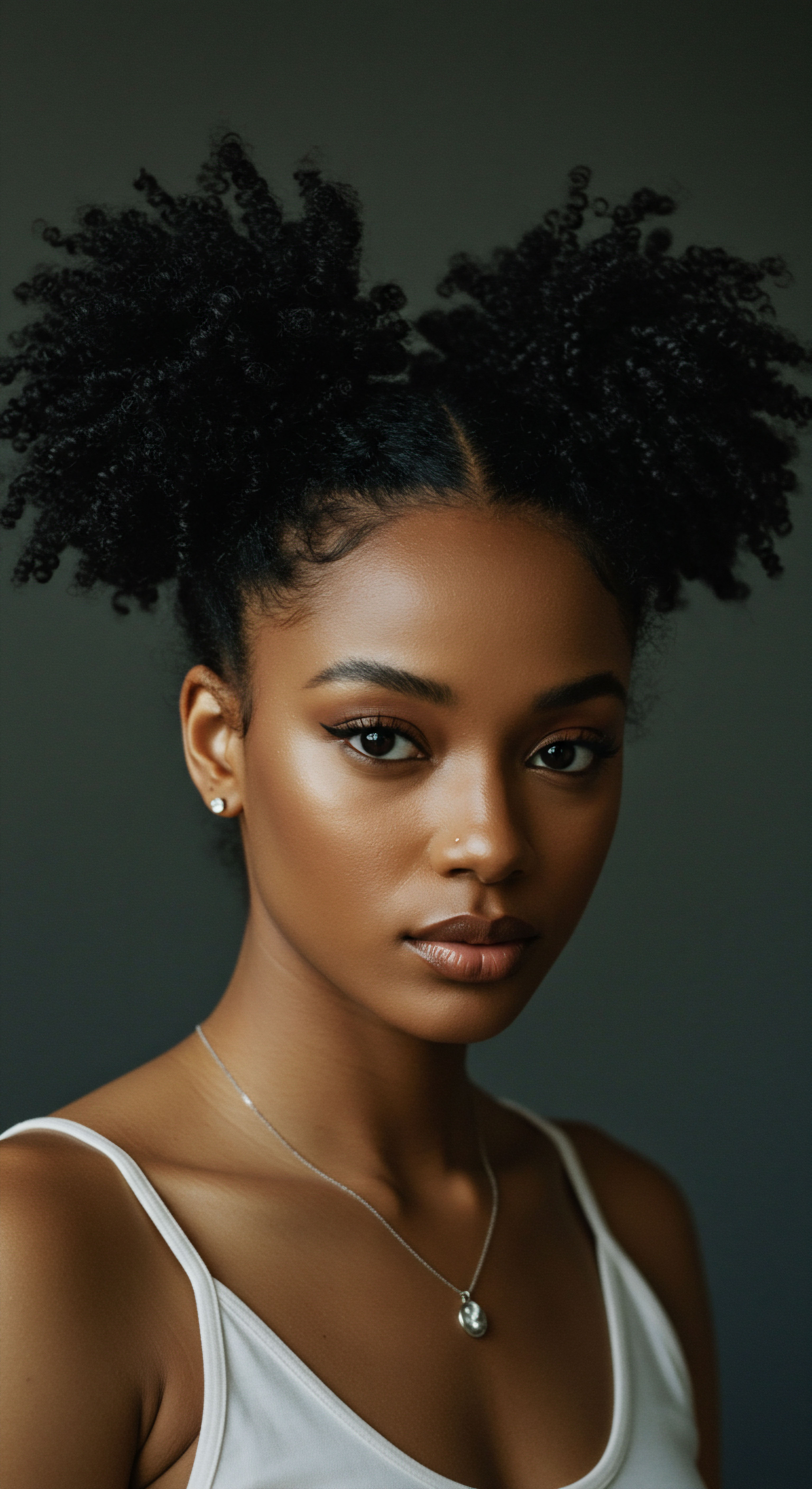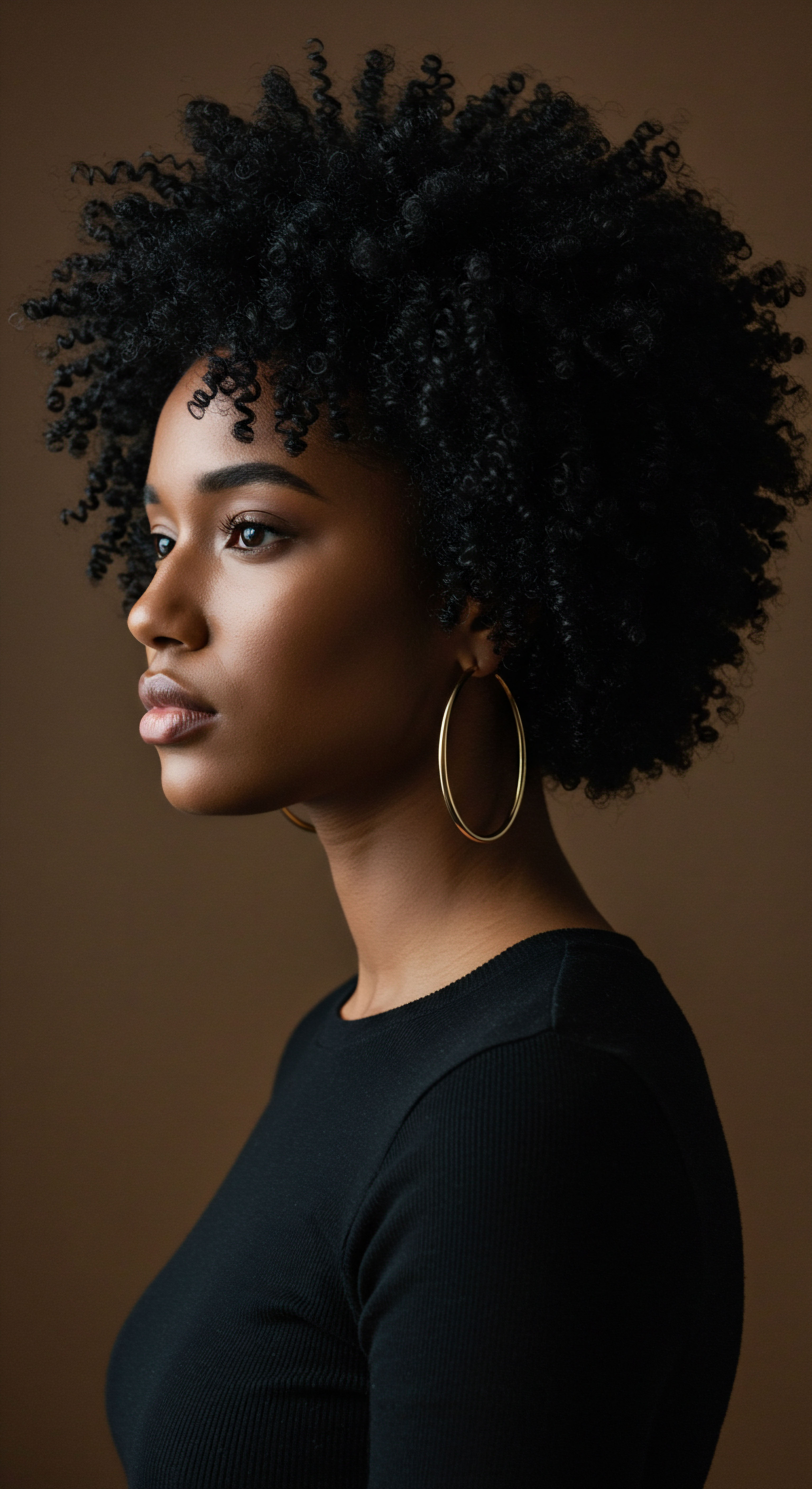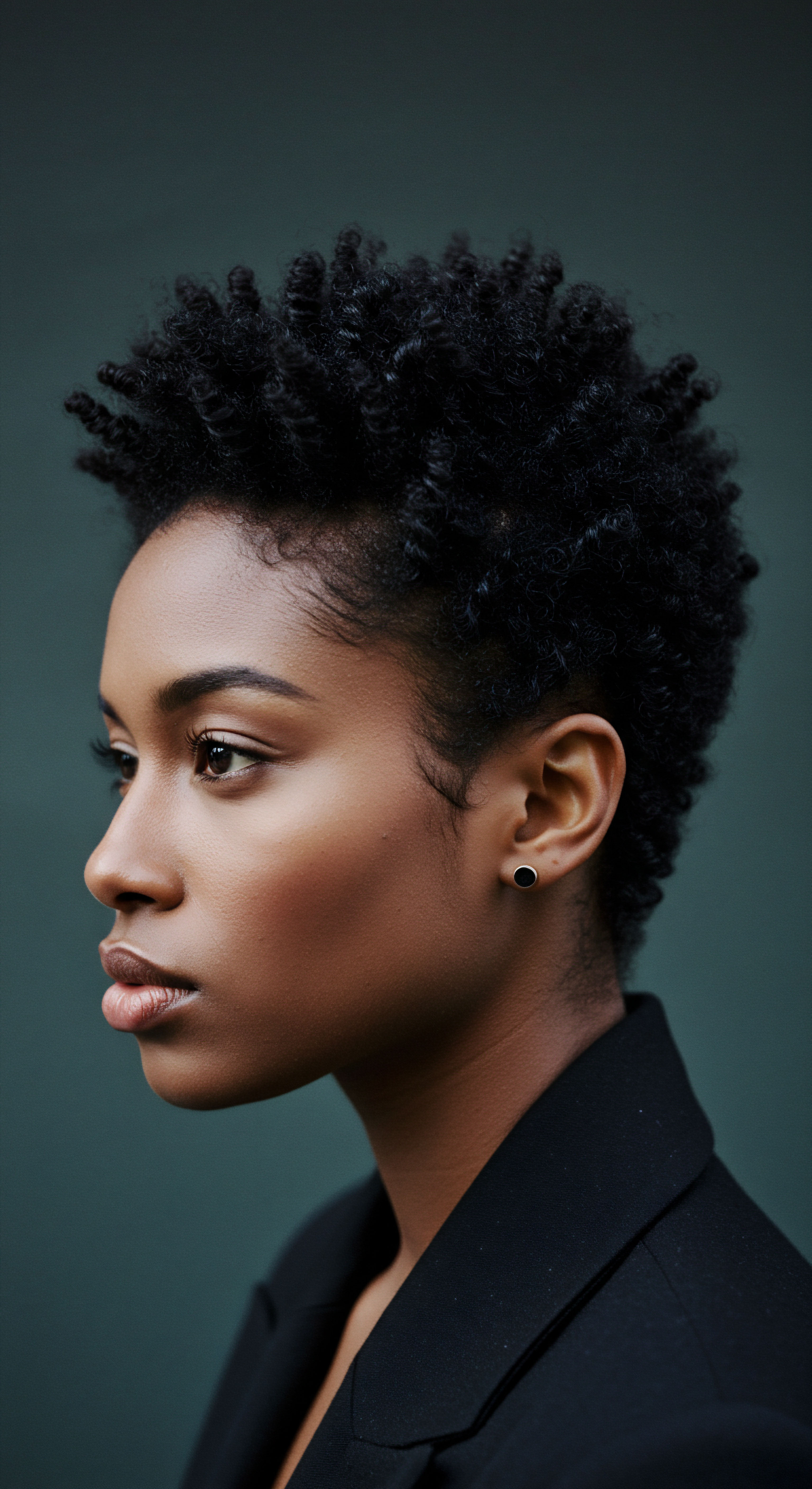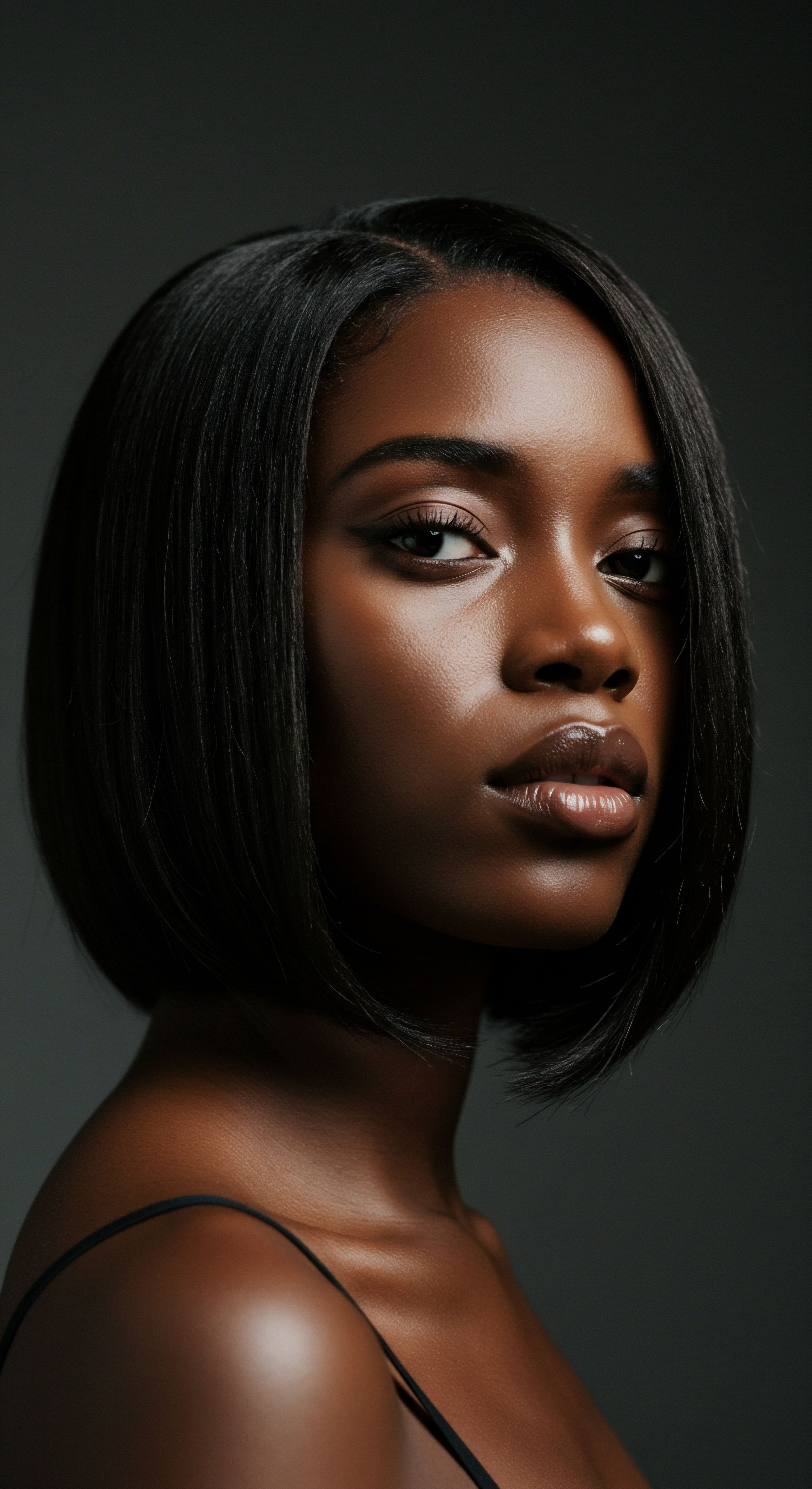
Roots
The whisper of ancient winds often carries scents that feel strangely familiar, a reminder that much of what we hold dear, even in our personal care, has roots reaching back through millennia. Consider the profound connection between early civilizations and the very ground beneath their feet, or the plants reaching towards the sun. Before grand markets and bustling ports, hair care was a deeply local affair, a testament to what nature provided within immediate reach. These early formulations, simple yet potent, laid the groundwork for the complex rituals that would later span continents.
Across various corners of the world, people instinctively turned to the bounty around them. In ancient Egypt, for instance, the desert climate necessitated protective measures for hair. Locally available plant-based oils, such as Sesame Oil, Castor Oil, and Moringa Oil, were essential for moisturizing and shielding strands from harsh environmental elements.
Animal fats also found a place in these early concoctions, serving as a base for hair gels and ointments to style and preserve coiffed locks. Archaeological findings reveal that ancient Egyptians even employed hair gels, some dating back 3,500 years, often composed of palm oils and animal fats.
Similarly, in the Indian subcontinent, where the practice of hair oiling holds a sacred lineage, indigenous ingredients were the bedrock of hair wellness. Ayurvedic traditions, thousands of years old, speak of using local herbs and oils. Coconut Oil, revered for its cooling properties, became a staple in tropical southern regions, while Mustard Seed Oil, prized for its warming effects, was favored in the north.
Amla Oil, derived from the Indian gooseberry, was celebrated for its rejuvenating qualities. These regional specialties highlight a profound, localized wisdom concerning hair health.
Early hair care relied on locally sourced oils, plant extracts, and animal fats, forming the elemental foundation for future practices.
The initial exchange of these ingredients was often informal, perhaps through neighboring communities or short-distance bartering. This modest movement of goods, however, gradually opened pathways for more distant connections. The sharing of simple remedies, a plant with unique properties, or a technique for extracting an oil, represented the earliest forms of trade in hair care. This slow expansion of knowledge and materials laid the foundation for the more elaborate trade networks that would soon begin to redefine what was possible in hair beautification.

How Did Early Civilizations Discover Hair Care Ingredients?
The discovery of hair care ingredients in ancient times stemmed from keen observation and experimentation with natural surroundings. Early humans noticed the effects of certain plants, clays, and animal products on their hair and scalp. For example, the soothing properties of aloe vera or the conditioning qualities of olive oil would have been observed through their use on skin or in food.
The desire to protect hair from sun, dust, and dryness, or to enhance its appearance, led to trying various available resources. This practical, hands-on approach, passed down through generations, formed a cumulative body of knowledge about botanical and mineral applications.
Consider the widespread use of Henna (Lawsonia inermis), a plant native to North Africa, the Middle East, and South Asia. Its leaves, when dried and crushed into a paste, yielded a rich reddish-brown dye for hair, skin, and nails. The cooling properties of henna were also noted, offering relief to the scalp. Such discoveries were not scientific in the modern sense, but rather empirical, built on repeated observation of cause and effect.
The earliest forms of hair cleansing also emerged from local resources, with civilizations like those in Mesopotamia and Egypt using clay and certain plant extracts. In the Indus Valley, soapberries like Sapindus, alongside Indian gooseberry and other herbs, were used for early shampoos. These localized innovations, born from necessity and a deep connection to the environment, were the true genesis of hair care.
| Region Ancient Egypt |
| Primary Ingredients Castor oil, Sesame oil, Moringa oil, Animal fats, Henna |
| Observed Benefits Moisturizing, protection, styling, conditioning, coloring |
| Region Indian Subcontinent |
| Primary Ingredients Coconut oil, Mustard oil, Amla, Shikakai, Soapnut, Henna |
| Observed Benefits Nourishment, growth, cleansing, scalp health, conditioning, coloring |
| Region Ancient Greece & Rome |
| Primary Ingredients Olive oil, Rosemary, Lavender, Plant ashes, Lead compounds (later) |
| Observed Benefits Shine, conditioning, fragrance, cleansing, coloring |
| Region Mesopotamia |
| Primary Ingredients Clays, Plant extracts, Essential oils |
| Observed Benefits Cleansing, conditioning |

Ritual
To truly understand the journey of ancient ingredients into hair care, we must consider the daily and ceremonial practices that transformed simple substances into revered rituals. A shift occurred as localized knowledge began to intertwine with the expanding arteries of trade, moving beyond immediate surroundings to embrace materials from distant lands. This expansion did not simply add new items to a cosmetic kit; it deepened the very meaning of hair care, elevating it from mere hygiene to an expression of status, spirituality, and cultural identity.
The opening of ancient trade routes acted as a circulatory system for cosmetic wisdom. The Incense Route, for instance, connecting the Mediterranean with East Africa and India, transported precious resins like Frankincense and Myrrh. While often associated with perfumes and religious ceremonies, these aromatic resins also found their way into hair preparations, prized for their scent and perceived purifying qualities. Imagine the transformation in hair care as these exotic, fragrant materials became available, adding layers of sensory experience and symbolic meaning to routines.
Beyond aromatics, other significant ingredients traveled far from their origins. Cinnamon and Cassia, originating from Asia, reached Egypt, where they were incorporated into perfumes and ointments that could be applied to the hair. The very act of preparing these complex blends, often involving multiple imported components, became a ritual in itself, requiring skill and a certain degree of wealth.
Ancient trade routes broadened the palette of hair care ingredients, transforming simple practices into elaborate rituals of beauty and status.

What Role Did Trade Routes Play in Shaping Ancient Hair Care Practices?
Trade routes were pivotal in diversifying and enriching ancient hair care practices, acting as conduits for ingredients, techniques, and cultural influences. The Silk Road, though famous for silk, also facilitated the movement of other valuable goods, including plant extracts and oils. This allowed for the introduction of ingredients like Ginseng from China, known for its rejuvenating properties, into regions further west. The exchange was not unidirectional; knowledge of hair oiling from the Indian subcontinent, using oils like coconut and amla, spread to other cultures as trade routes expanded.
The Romans, known for their elaborate hairstyles and beauty standards, were particularly reliant on trade for their cosmetic supplies. They imported hairpins and ornaments crafted from gold, silver, pearls, and jewels. Their quest for diverse hair colors led them to import dark hair from as far as India for wigs, signifying Rome’s dominance and access to distant resources. The widespread use of various hair coloring agents, from black to blonde, was enabled by a network that sourced ingredients from across their vast empire and beyond.
- Henna ❉ Originating in North Africa, the Middle East, and South Asia, henna traveled extensively, becoming a cherished hair dye and conditioner across many cultures, including ancient Egypt and India, where it was used for both cosmetic and ceremonial purposes.
- Olive Oil ❉ A staple in the Mediterranean, olive oil from Greece and Rome was not only consumed but also widely used as a hair conditioner, often infused with herbs like rosemary and lavender, and its trade spread this practice.
- Aromatic Resins ❉ Frankincense and myrrh, sourced from Yemen and Somalia, were transported via the Incense Route to Egypt and Rome, where they were used in perfumes and hair preparations for their scent and symbolic value.
- Spices and Herbs ❉ Cinnamon, cassia, and cardamom, originating from Asia, found their way into Egyptian hair ointments and perfumes, adding fragrance and perceived medicinal properties.
- Botanical Oils ❉ Beyond local varieties, trade introduced oils like almond and palm to Egypt, and later, more specialized oils like argan and jojoba, although these gained wider prominence in later periods.

How Did Imported Ingredients Change Daily Hair Care?
The arrival of imported ingredients transformed daily hair care from a purely utilitarian activity into a more sophisticated and often luxurious practice. Access to new oils, scents, and pigments meant that hair could be treated with greater care, styled with more versatility, and imbued with personal or social significance. For instance, the availability of various plant oils allowed for more targeted conditioning, addressing concerns like dryness or lack of shine. The addition of aromatic resins and spices meant that hair could carry pleasant fragrances, reflecting personal refinement or status.
Moreover, the trade in diverse hair coloring agents allowed for greater aesthetic choice. Roman women, for example, could achieve fashionable blonde shades by importing hair for wigs or using plant-based bleaching agents, while others sought dark hair with walnut shells or even lead compounds. This expansion of options created a new dimension of self-expression through hair. The preparation of these imported ingredients also influenced daily life, as people would engage in grinding, mixing, and infusing to create their desired hair treatments, turning a simple task into a more involved and often communal activity.

Relay
To truly grasp the long reach of ancient trade into the realm of hair care, we must consider not just the physical ingredients that traversed vast distances, but also the intricate interplay of economic forces, social aspirations, and cultural assimilation that accompanied them. How did the movement of a seemingly simple oil or a vibrant plant dye become a testament to human ingenuity and, at times, a quiet commentary on societal values? This deeper understanding reveals how the ancient world laid down foundational principles for hair wellness that echo even today, sometimes in unexpected ways.
The exchange of hair care ingredients was never a mere transaction; it was a complex system of supply and demand, influenced by geopolitical power and prevailing beauty standards. Take, for instance, the Roman fascination with hair color. While indigenous remedies existed, the desire for specific shades, particularly blonde, led to the import of hair for wigs from Northern Europe, a direct consequence of conquest and trade. This practice highlights how trade not only brought new ingredients but also solidified cultural preferences and social hierarchies through appearance.
The very concept of hair care as a symbol of status was reinforced by the rarity and expense of imported goods. Only the affluent could regularly access the exotic oils from distant lands or the prized henna from the Middle East. This created a tangible link between access to global trade networks and personal presentation, a silent language of wealth expressed through lustrous, fragrant, or vividly colored hair.
Ancient trade routes facilitated the global movement of hair care ingredients, revealing deep cultural connections and sometimes unforeseen consequences.

How Did Trade Introduce Harmful Ingredients into Ancient Hair Care?
While ancient trade undeniably enriched hair care with beneficial botanicals, it also, perhaps inadvertently, introduced substances with significant health risks. A compelling, albeit sobering, example comes from ancient Rome. The Romans, alongside the ancient Greeks, sought to alter hair color, particularly darkening graying strands or achieving deeper black hues.
One method involved dipping Lead Combs into vinegar, then running them through the hair, which would leave a dark residue. Another popular recipe for darkening hair involved fermenting leeches for two months in a lead vessel, then grinding them into a paste for application.
This practice, while effective in coloring, introduced lead, a highly toxic heavy metal, directly to the scalp. Historical studies and archaeological findings suggest that chronic lead exposure was a problem in Roman society, affecting everything from pipes and dishes to cosmetics and hair dyes. A study by Dr. John H.
D’Arms on Roman lead consumption noted that while direct links to widespread poisoning are debated, the pervasive use of lead in daily life, including cosmetics, certainly contributed to exposure levels, particularly among the elite who could afford such elaborate treatments. This illustrates a profound paradox ❉ the pursuit of beauty, fueled by the availability of new materials through trade, could also carry unseen dangers. The legacy of such practices reminds us that innovation, even in ancient times, sometimes came with a hidden cost.
The movement of goods along ancient routes meant not only the exchange of beneficial ingredients but also, at times, the spread of potentially hazardous substances.

What is the Enduring Legacy of Ancient Trade on Modern Hair Care Ingredients?
The legacy of ancient trade on contemporary hair care is far more pervasive than often considered. Many of the fundamental ingredients and concepts we use today have direct lineages to these historical exchanges. The enduring presence of certain botanical oils serves as a clear testament.
Olive Oil, a staple in ancient Greek and Roman hair care for its moisturizing and shine-enhancing properties, remains a popular ingredient in modern conditioners and treatments. Similarly, Castor Oil, a favorite in ancient Egypt for conditioning and strengthening hair, is still widely used, especially for textured hair, due to its viscosity and perceived growth-promoting qualities.
The widespread use of Henna as a natural hair dye and conditioner continues globally, a direct continuation of ancient practices from North Africa, the Middle East, and India. Beyond specific ingredients, the very idea of combining diverse plant extracts for targeted hair concerns, a practice rooted in Ayurvedic traditions and Egyptian apothecaries, influences modern cosmetic formulation. Today’s cosmetic chemists, while utilizing advanced science, often look to these historical applications for inspiration, recognizing the time-tested efficacy of many ancient botanicals.
The global marketplace for hair care ingredients, a system built on complex supply chains, is a direct descendant of the ancient trade routes that first connected disparate regions. From the essential oils that add fragrance to our products to the plant proteins that strengthen strands, the ancient world’s pursuit of hair wellness laid down the foundational network. The demand for specific ingredients, once met by arduous overland caravans and perilous sea voyages, is now fulfilled by global shipping, but the underlying principle of seeking the best from around the world for hair remains unchanged.
| Ancient Ingredient Olive Oil |
| Historical Origin/Trade Route Mediterranean (Greece, Rome) |
| Modern Application in Hair Care Conditioners, hair masks, shine serums |
| Ancient Ingredient Castor Oil |
| Historical Origin/Trade Route Ancient Egypt, India |
| Modern Application in Hair Care Hair growth serums, moisturizing treatments, scalp oils |
| Ancient Ingredient Henna |
| Historical Origin/Trade Route North Africa, Middle East, South Asia |
| Modern Application in Hair Care Natural hair dyes, conditioning treatments |
| Ancient Ingredient Amla (Indian Gooseberry) |
| Historical Origin/Trade Route Indian Subcontinent (Ayurveda) |
| Modern Application in Hair Care Hair oils, shampoos for growth and scalp health |
| Ancient Ingredient Frankincense & Myrrh |
| Historical Origin/Trade Route Arabia, East Africa (Incense Route) |
| Modern Application in Hair Care Fragrance in hair products, scalp soothing formulations |
| Ancient Ingredient Ginger Oil |
| Historical Origin/Trade Route Asia (Spice Routes) |
| Modern Application in Hair Care Scalp stimulation, hair growth formulations |
| Ancient Ingredient Silk Proteins |
| Historical Origin/Trade Route China (Silk Road) |
| Modern Application in Hair Care Conditioners, serums for smoothness and elasticity |

Reflection
The story of ancient trade and its influence on hair care is a testament to humanity’s persistent desire for self-expression and wellness, a timeless pursuit that connects us to our ancestors across continents and centuries. Each ingredient, from the humble olive oil to the exotic frankincense, carries within it the echoes of distant lands, arduous journeys, and shared human experiences. The knowledge passed down, adapted, and expanded through these exchanges reminds us that our hair, in its diverse textures and forms, has always been a canvas for culture, a symbol of identity, and a reflection of the world’s unfolding story. It beckons us to consider the continuous dialogue between nature’s offerings and human ingenuity, a conversation that continues to shape our routines today.

References
- 1. R. C. K. Singh, V. P. Singh, & R. Kumar. “History of Natural Ingredients in Cosmetics.” MDPI, 2021.
- 2. “A History of Haircare.” Amazingy Magazine, 2024.
- 3. M. Cartwright. “Cosmetics in the Ancient World.” World History Encyclopedia, 2019.
- 4. “Silk Road Blow Dry Serum.” Ibiza Hair Tools .
- 5. “Rediscovering Historical Hair Care Practices.” Fabulive .
- 6. M. K. D. Al-Mashhadani. “Heavenly Concoctions ❉ the World of Egyptian Perfumes and Oils.” Nile Scribes, 2021.
- 7. Z. Imran. “The Intricacies of Henna’s History and Cultural Significance.” Aramco Expats, 2023.
- 8. F. E. Siddig. “Analysing Ancient Nubian Cosmetics and Remedies.” Arab-German Young Academy .
- 9. “Henna Is How We Wear Our Roots.” BLAM UK CIC, 2025.
- 10. “Hair Oiling ❉ The Ancient Secret to Lustrous Locks.” Trell, 2024.
- 11. “The History and Origins of Henna Powder ❉ A Natural Dye with a Rich Legacy.” Botanical Elements, 2025.
- 12. “Ancient Egyptian Trade ❉ History, Goods Types, Routes & Facts.” Egypt Tours Portal, 2020.
- 13. R. Kumar. “The Bonding Ritual of Hair Oiling.” Brown History, 2023.
- 14. “Silk Hair Conditioner.” Arish Bionatural .
- 15. “The colourful world of hair dye.” RSC Education, 2021.
- 16. “The henna plant ❉ Transcending time, religion and culture.” Natural History Museum .
- 17. “Henna.” Wikipedia .
- 18. “Ancient Trade ❉ Routes & Egypt Trade.” StudySmarter, 2024.
- 19. “Part 3 ❉ Historic Value of Essential Oils—Egypt.” doTERRA .
- 20. “Oils In Haircare Formulations ❉ Roles & Responsibilities.” Learn Canyon .
- 21. “Hair Repair Therapy Oil.” Silk Road Wellness .
- 22. “The Legacy of Lathers ❉ Tracing the Historical Use of Natural Ingredien.” Medium, 2023.
- 23. “Rooted in Nature ❉ Botanicals for Hair and Responsibly Sourcing Them.” Cosmetics & Toiletries, 2019.
- 24. “Ancient Trade Items.” Nabataea.net .
- 25. P. Lenz. “A history of… hair products.” Paul Lenz, 2025.
- 26. “Olivos Perfume Soap Spice Route 250g 8.8 oz.” BeautyWays.com, 2016.
- 27. J. Trafford. “The Medicine Behind the Nativity Gifts ❉ Frankincense and Myrrh Revisited.” Living History, 2023.
- 28. “Hair Dye History ❉ Crazy Ways Ancient People Colored Their Hair.” Artisan Hair Cary, 2020.
- 29. R. C. K. Singh, V. P. Singh, & R. Kumar. “History of Natural Ingredients in Cosmetics.” MDPI, 2021.
- 30. “The Ancient Benefits of Ginseng Leaf Extract for Your Hair.” NaturallyCurly – Beautycon.com, 2016.
- 31. “CHI Silk Infusion hair serum / 177ML 6oz.” CHI Egypt .
- 32. “Intense Repair Shampoo 250ml.” Silk Essence .
- 33. “The History of Aromatherapy.” Quinessence Aromatherapy .
- 34. “Medicinal plants and their derivatives for skin and hair ❉ a Mediterranean perspective of women care.” Journal of Ethnopharmacology, 2025.
- 35. “The Complete History of Hair Care Products.” Essential Wholesale, 2023.
- 36. “Hair Care Through the ages ❉ Inspired by the past, Designed for the future.” Safic-Alcan .
- 37. “SOS Organics Spice Route Luxury Bath Soap, 100 gram.” Amazon.in .
- 38. “Protein Therapy Spray.” Routes Hair Extensions .
- 39. “Hair Care Through the Ages ❉ From Lizard Gel to Powdered Wigs.” Inova Professional, 2018.
- 40. “Lead ❉ Versatile Metal, Long Legacy.” Sites at Dartmouth .
- 41. “Gladiator sweat and leech hair dye; how to survive in Ancient Rome.” Historia Magazine, 2020.
- 42. “Medicinal plants used in cosmetics for skin and hair care.” ResearchGate, 2024.
- 43. “Hair Care Secrets of the Past ❉ What Our Ancestors Used for Healthy Hai.” Beauty Brains and Brawn, 2024.
- 44. “Spice Route | Natural Energising Remedy.” Stimuli.Life .
- 45. A. D. M. L. E. W. J. R. A. D. M. L. E. W. J. R. “History of hair colouring reviewed.” Personal Care Magazine, 2009.
- 46. “Melting Balm – Ayurvedic – Journey To The Spices Route.” La Sultane de Saba USA .
- 47. R. C. G. N. S. A. G. S. S. A. K. R. A. “Cosmetics Potential of Herbal Extracts.” ResearchGate .
- 48. “Why Botanical Extracts Are Essential For Scalp Care.” Learn Canyon, 2025.